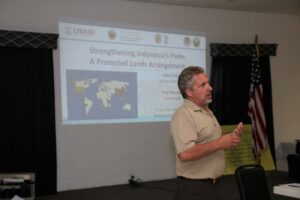 The chapter’s guest speaker for the September member’s meeting was Chris Lowie. Chris (pictured at left) is the refuge manager of the Great Dismal Swamp National Wildlife Refuge (GDSNWR).Chris began his presentation by explaining some of the recent hunting rules and regulations being implemented at the refuge. He then presented members with an overview of a five year program that was established to create a “Sister Protected Lands Partnership” between the GDSNWR and a park in Indonesia.
The chapter’s guest speaker for the September member’s meeting was Chris Lowie. Chris (pictured at left) is the refuge manager of the Great Dismal Swamp National Wildlife Refuge (GDSNWR).Chris began his presentation by explaining some of the recent hunting rules and regulations being implemented at the refuge. He then presented members with an overview of a five year program that was established to create a “Sister Protected Lands Partnership” between the GDSNWR and a park in Indonesia.
In 2013 the United States Agency for International Development (USAID) was contacted by the Indonesian government to obtain assistance with strengthening their country’s ability to develop and manage their parks. Working through the US Department of the interior and the International Technical Assistance Program, the GDSNWR was chosen for the project. The choice was based on the project’s purpose, challenges and the fact that the park had similar landscape as the designated Indonesian park. The park in Indonesia was established in 2004 as the Sebangua National Park. The park covers over 1 million acres and is home to the largest population of orangutans in the world. Like the GDSNWR the park is a peat swamp forest. 
Several scientific exchanges were made between 2015 and 2020. In 2015 Hydrology Assessment training sessions and workshops were conducted by GDSNWR staff on the island of Borneo where the park is located. Later that year some of their staff members came here to tour and observe activities at the GDSNWR. Staff exchanges continued from time to time in order to observe various areas of park management until 2020. Areas of exchange and training included advanced hydrology, hydrology data analysis, ecotourism planning, park interpretation and environmental education.
This exchange program aided the staff of the GDSNWR to validate that what is being done at the refuge is on the right track and can be used in other countries around the world to develop and manage protected lands. The staff of the Sebangua National Park have now begun sharing what they have learned by training staff from other Indonesian parks.
